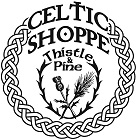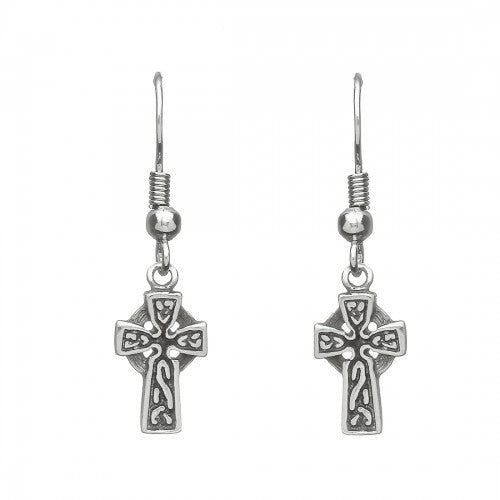Pewter Celtic Pendants
Pewter Celtic Chokers on black adjustable full length cord in Celtic designs.
The Celtic Cross: The subtle merging of cultures characterising the ancient Celtic church is brilliantly represented in the Celtic Cross. Here the Sun Wheel, symbol of the eternal cycle of life, death and rebirth is joined with the Christian Cross symbol of the risen Christ. It is believed that St. Patrick combined the symbol of Christianity, a cross, with the symbol of the sun, to give pagan followers an idea of the importance of the cross by linking it with the idea of the life-giving properties of the sun. To this day, at dozens of monastic sites throughout these islands. these exquisitely carved monuments bear silent testimony to the deep faith and bold artistry of their creators
The Claddagh: 16th century legend tells of Richard Joyce from Claddagh, Co. Galway, who was captured by Moor pirates and enslaved. In captivity he became a master of his trade (Goldsmith). His skillful hands shaped a unique ring for the woman he could never forget at home. After eight years he was released. He returned to Ireland, and to his great joy her heart remained his, never to be separated again. The Claddagh ring is a great traditional wedding ring, known the world over. Today it is commonly accepted that the joining hands, heart, and crown represent a perpetual bond of friendship, love and loyalty. Wearing a Claddagh ring with the heart pointing out signifies the wearer is unattached. If the heart is pointing in towards the wearers own heart, then that heart is taken.
The Harp: Legend: Based on the ancient lyre, the Irish harp is one of the world's oldest instruments. The Harp motif commemorates the rich legacy of the Bardic tradition. For a thousand years in his multifaceted role as a poet as a poet and storyteller, teacher and historian, guardian of the law and of the sacred rituals, the Bard was revered throughout Celtic society as a man of wisdom. The ancient Irish kings employed harpists to entertain them. At one point in Irish history, conquering invaders made it illegal to possess an Irish harp and set out to burn every harp in Ireland in an attempt to kill the "Irish spirit." Successors to the Bards, wandering poets and storytellers played a unique role of preserving and nurturing our Celtic identity. Today, greatly honored, the harp is the national emblem of Ireland.
Celtic Spiral: Perhaps the best known or all Celtic motifs, the Triple spiral dates back to the 5,000 year old tomb complex at Newgrange. Thought originally to have symbolized the Eternal Cycle of Life, Death, and Rebirth, in later times it came to represent the Great Goddess and her threefold manifestation of virgin, mother, and crone.
The Heart: The heart as a symbol of love dates back to Medieval times. The Celtic Heart marries the enduring Heart shape with the beauty of the unbroken line. Perfect in symmetry the interlacing lines stand for everlasting love.
Tribal Spiral: The most common of the multi-spirals is the triple spiral or Triskele, which for Christians represents the Holy Trinity, for the Celts the three stages of the feminine life cycle: maiden, mother and old wise woman. The Celtic Spiral is probably the oldest symbol of human spirituality and the most commonly recognized Celtic design motif. It has become a powerful symbol for creation and growth. It appears on a myriad of ancient artifacts, as well as on stone monuments such as Newgrange, in Ireland. It is uncertain what the religious significance was to the pagans of Newgrange. It may have been used simply for decoration, but it probably had some connection with the sun. It was a much favored ornamental device used in the Christian Golden Age and remains a unique symbol of our Celtic heritage, with many modern interpretations.
Shamrock: The Shamrock is a three leaved clover that grows in Ireland. It is said that while Patrick was preaching an open-air sermon on the Holy Trinity, and an old Druid began to heckle him, ridiculing the idea that the three divine beings could somehow be one. Patrick plucked a shamrock and, holding it aloft, replied, "Just as the three leaves of the shamrock are separate yet part of the whole so it is with the Trinity of the Father, Son and Holy Spirit." Today wearing the shamrock is an integral part of St. Patrick's Day celebrations.
Trinity Knot: (Triquetra) is the simplest of Celtic Knots symbolizing a triune God. For the Celts everything came in threes, maid, mother, crone & the three elements: earth, fire and water. Christianity embraced this knot to symbolize the Father, Son and Holy Spirit in many of the early Christian illuminated manuscripts such as the Book of Kells. The use of the Trinity Knot in jewelry design is associated with eternity and eternal love.
Celtic Round: The simple, yet profound, beauty of the unbroken line. forming delicately complex patterns of weaves and knots, perfect in their symmetry, permeates all of the great achievements of Celtic art. The interlacing lines of the Celtic Knot stand for "no beginning, no ending," the continuity of everlasting love and binding together or intertwining of two souls or spirits. Christianity has embraced much of the ancient Celtic symbolism and had adapted many Celtic Knots into high crosses and illuminated manuscripts.
























